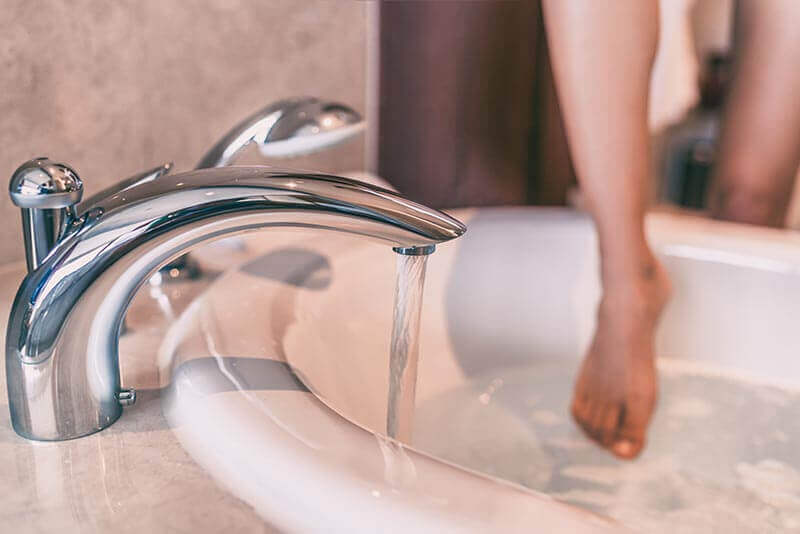Baths vs Showers: Which Uses Up More Water?

Are you more of a bath or a shower fan?
Whether you prefer a nice long soak in the bath or a relaxing and refreshing wash in the shower, one of the questions you might ask yourself is, which one uses up more water?
Conserving water is not only better for the environment, but it will help reduce your water bill, making it a real win-win situation! In this article, we’ll walk you through the use of water for both baths and showers, and how you can help conserve water while still getting squeaky clean.
Baths vs showers
When it comes to the age-old question, which uses more water - a bath or a shower - most people generally believe a bath uses the most water.
Get a FREE Brochure
Fill out the form in seconds and discover our full range of assisted bathing showers and baths.

When you turn on the taps in your bath, you tend to think that more water has to be used to fill it up to a satisfactory height. No one likes a shallow bath after all! But, when you step into your walk-in shower, do you consider how long you stand under the water? Or how long you normally leave the water running while you step in and out of the shower?
You need to take these factors into consideration when thinking about which option ends up using more water.
Let’s look at bathtubs first.
How much water do you use in the bath?
Did you know that on average, each person uses roughly 80-100 gallons of water each day in the home?
That includes everything from flushing your toilet, using the dishwasher and washing machine, turning on the tap to wash your hands, brush your teeth, and pour yourself a glass of water. And, yes. It also includes filling up your tub.
Depending on your water level and the size of your tub, a bath on average uses about 30 gallons of water. Now, although soaking in a hot, bubbly bath scented with your favourite bath soak is one of our top luxuries in life, if you indulge in one daily, then you could be using over 200 gallons of water a week - just on baths!
But because we know baths are so much more than just a way to get clean - we use them for relaxing, as a mood enhancer, for health and mobility - we know you won’t want to stop having baths altogether.
This is where it’s all about compromise. Mix things up by having fewer baths. Treat them as a luxury or as a reward and make them something to really look forward to. And later, we’ll show you some other ways you can conserve water in the tub.
How much water do you use in the shower?
Even though an hour-long bath conserves more water than an hour-long shower, showers, in general, tend to use less water than a bath.
Of course, this also depends on factors such as the size of your showerhead and the strength of your water pressure. Standard showerheads use 2.5 gallons of water per minute. If you were to take a long shower (call it 10-15 minutes) then the amount of water you would use would actually be similar to a standard bath.
This means if you think taking a shower is better for the environment (and your water bill) then you need to think again! Lengthy showers like this - even though they feel amazing - end up using just as much water as you would if you fancied an hour’s soak in the tub. And considering the average shower time is 8 minutes, you might be using more energy and water than you think.
If you’re lathering up in the shower, washing, and conditioning (and repeating) your hair, and singing your favourite songs as you wash, then you’re allowing 2.5 gallons of water to escape down the drain every minute. Letting your shower run even for a few minutes means more water consumption.
But, don’t worry. We’ll show you how to change your bathing habits to make a real difference.
How to conserve more water in the bath and shower
On average, it is clear to see that a bath uses more water than a shower. But, if you take longer showers more frequently, then a shower might end up using the most water. It all depends on your habits and your bathing/showering requirements.
The bathroom is where we use the largest amount of water. But, it’s also the room where we can make the greatest effort to conserve it.
Once you realise just how much water you use on a daily basis, from washing your hands to washing your dishes, you will become far more conscious of it. Being aware of how much water your everyday activities are using will naturally make you more conservative. And this can help you choose whether to unwind in a bath or just have a quick wash under the showerhead.
Here are some tips to conserve water in the bath and in the shower.
1. Take shorter showers
We know it can be tempting to step into your walk-in shower and spend half an hour relaxing under the warm water jets, but this isn’t great for conserving water. Especially if you and other members of your household are indulging in them daily.
Consider limiting your time in the shower, and cutting it in half. A 5-10 minute shower should be all you need to come away clean and refreshed.
2. Fit an AAA-rated showerhead
These showerheads can reduce the amount of water you use in the shower by roughly 9 litres per minute. You could also have a flow restrictor installed to reduce the amount of water the shower emits.
3. Take baths as a treat
If you are able to use both the bath and the shower comfortably, then try to limit the number of baths you take. Instead of having one every day, treat yourself to one once or twice a week. This will help limit your water consumption and it will make your baths feel all the more special and beneficial.
4. Don’t overfill your tub
Although it can be tempting to luxuriate in a full to the brim bath, if you are keen to conserve your water then turn the tap off sooner. Instead of overfilling your bath, fill it just enough so it will cover your body when lying down or waist-height if sitting up in a walk-in bath.
5. Check the temperature
It can be so easy to turn the water on in your bath, pop in the plug, and just walk off and forget about it as it fills. But one of the most wasteful uses of water in the bath is filling it with too much hot water. And then having to use additional cold water to cool it down.
Make sure you keep an eye on the temperature of your water as the bath fills so you don’t have to top it up with cooler water once it’s ready.
6. Don’t lose your cool
When you turn on your shower and it runs cold for a few seconds before warming up to your perfect temperature, it’s easy to just let the water go right down the drain. Instead of wasting this water, have a bucket to hand and catch it as it runs. You can then use this cold water to water your indoor plants, the garden or to clean with around the house. It’s all about being creative!
7. Plug it up
An easy way to lose water in the tub (which you then top up, using even more water) is by having an ill-fitting plug. Check your bath plug to make sure it isn’t letting any water out. If it is then get a new plug fitted and enjoy a fuller bath for longer.
At Premier Care in Bathing, we want to help you have the best bathing experience possible. So you can relax, recharge, and enjoy this time safely. Now you have a better understanding of whether a bath or a shower uses the most water, you can make the right decision for your and your family’s needs.
And if you need any more advice when it comes to installing a walk-in bath, walk-in shower, or wet room, and which option is best for you and your needs, just get in touch. Our friendly and extremely knowledgeable team will help however they can.
